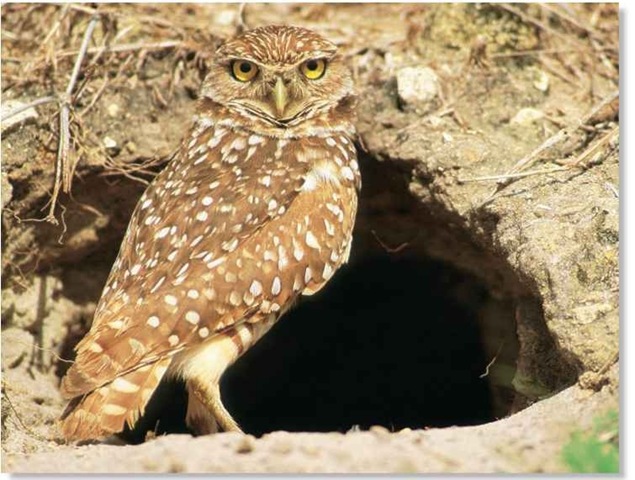ORDER
Strigiformes
FAMILY
Strigidae
GENUS & SPECIES
KEY FEATURES
Nests in abandoned underground rodent burrows, and leads a largely terrestrial life
Has long legs, unique among North American owls, enabling it to stalk prey on the ground An accomplished vocalist, it mimics a rattlesnake’s rasp to warn off predators
WHERE IN THE WORLD?
Found in grassland from British Columbia in Canada, through western U.S. and central Mexico, to Tierra del Fuego in South America
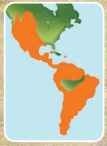
Lifecycle
The burrowing owl is primarily a ground-level operator, nesting underground and running after prey, but it is also a clever hunter, hovering in flight above its target.
HABITAT -
The burrowing owl’s range includes prairies and plains. Level, open, dry vegetation — found in Canada, the western U.S., Mexico and the treeless pampas of Central and South America — provides hiding sites for the young, while allowing full vision for adults.
The male usually “borrows” an abandoned burrow of a badger; prairie dog or; in South America, viscacha, but he can excavate his own, too. The burrow slopes gradually and then turns abruptly right or
left. This ensures that the nest chamber at the end of the tunnel is as dark as it can be, an essential feature for added protection of eggs and young. A network of branching tunnels provides food-storage areas and escape routes. Raised mounds, fences or rocks make perfect perches for observing prey. Migratory only in its northern range, the owl often overwinters in the south, setting up permanent residency to keep the burrow clean.
Hide and seek
Grasses provide an effective cover against predators and an excellent lookout for prey.
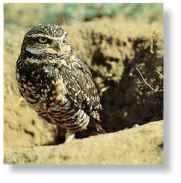
A Staking claim Taking over a prairie dog’s burrow, the male enlargesthe tunnel, making a home.
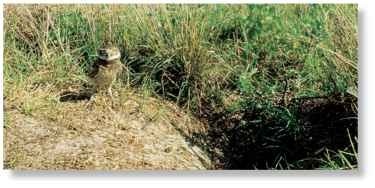
BEHAVIOR
Considered comical because of its bowing display, the male burrowing owl dips its body forward as it sings, cu-coo, cu-coo, a mellow love song that is one of approximately 17 vocalizations.This song, repeated every hour at night during courtship, is also emitted for territorial defense. Bobbing up and down for a better view, the burrowing owl guards the immediate area of its burrow, but allows feeding in commonly shared areas by adjacent owl pairs. Females rasp when begging for or receiving food from the male during incubation, or when passing food to the young.The burrowing owl utters a buzzing “rattle” resembling the sound of a rattlesnake when disturbed, or when cornered by predators such as badgers or snakes. Burrowing owls line their nest chambers with 1-2″ of dung, which provides insulation and also masks the ► On guard odor of the nest to protect the No trespassing owls or young from hungry predators. predators allowed here.
FOOD & HUNTING
Most of the year, the owl hunts from sunrise to sunset. In the spring, it pursues small mammals at low-light periods, especially during the cool early evening. In the summer heat, these small mammals retreat underground to stay cool, and the burrowing owl then stalks larger nsects, such as locusts, grasshoppers, dragonflies and dung beetles.
The burrowing owl runs on its long legs and snatches smaller prey with one foot. With broad wings unfolded, the owl can also swoop in for the kill from a perch near the nesting hole.The owl quietly hovers, taking deadly aim at a mouse, cottontail or even a ground squirrel that is equal to its own size. Feathers, hair and bones, which are all indigestible, accumulate in the owl’s gizzard and are regurgitated in the form of pellets.
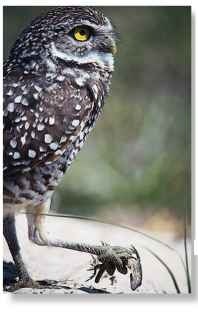
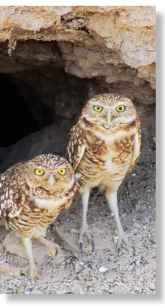
In Greek mythology, Athena, the daughter of Zeus and goddess of wisdom, arts and warfare, was often depicted with an owl on her shoulder, hence the burrowing owl’s genus name, Athene.
The burrowing owl’s species name, cunicularia, comes from the Latin word cunicularius, meaning “a miner or burrower.”
A PLAN OF ATTACK

1 A perfect view…
The owls emerge at sunrise, ready to start another day.Turning their heads up to 270°, they search carefully for prey.
2 Silent suspension…
With talons drawn, an owl flies toward an unwary beetle, then quietly hovers, its softened feathers deadening the sound.
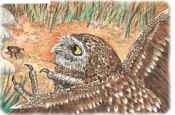
3 Swift descent…
The owl then swoops to capture the dung beetle with its needle-sharp talons. Legs and talons are stretched for the kill.
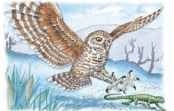
4 Strike to survive
The owl now chases one of its favorites, an uta lizard.The burrowing owl must eat more than its weight each day.
BREEDING -
Before initiating courtship, the male owl selects a burrow and prepares a nest. Up to 10′ long and 6″ wide, the tunnel ends with a dark 12-18″ wide nesting cavity, lined with dung and feathers. Once it is complete, the courtship ritual begins. The pair mates after an extended period of songs, billing, mutual nibbling of the head feathers and food presentation. Since burrowing owls do not form permanent bonds, the mating cycle is repeated annually. After mating, the female lays one egg every other day Incubation starts with the first egg; the parents take turns incubating the 6-11 eggs.The female’s absence is brief,however, because the male brings her food.The grayish-white owlets weigh 0.3 oz. each and hatch at intervals; the oldest can be two weeks older than the youngest.
A first look
A 2-week-old is sheltered by its parent during its first venture out of the burrow.
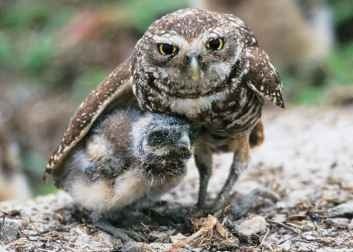
CONSERVATION
Rodent burrows usually offer an ideal protective environment for the nesting burrowing owl. But ranchers, trying to control squirrel and prairie dog populations, have destroyed burrows and inadvertently poisoned burrowing owls. Insecticides and rangeland conversion have reduced the owl’s food supply and habitat.The burrowing owl has been on the National Audubon Society’s Blue List, and The Committee on the Status of Endangered Wildlife in Canada has listed it as an endangered species.
Profile
Burrowing owl
One of the few owls adapted for land dwelling, the burrowing owl is an ultra-efficient daytime hunter, attacking prey on land or in the air.
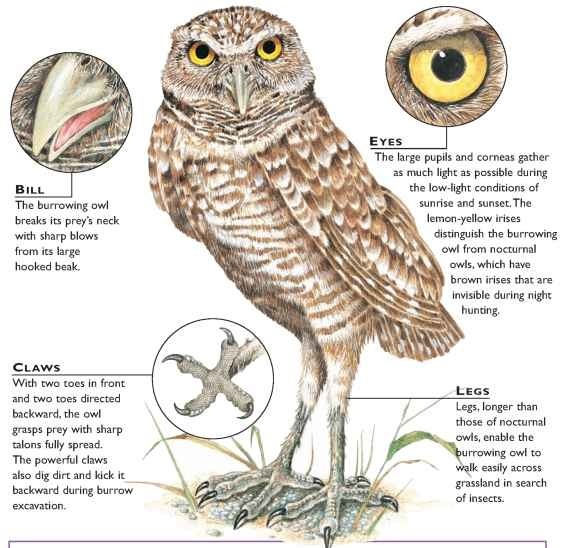
CREATURE COMPARISONS -
The closest relative of the burrowing owl is the little owl (Athene noctud). Weighing in at 4-7.5 oz., it is not the world’s smallest owl, despite its name. Both owls have brown plumage streaked with white and scantily feathered legs and toes. Noisier and more nocturnal than the burrowing owl, the nonmigratory little owl spends less time on the ground and lives all over Europe in old houses, ruins, caves, wells or low cliffs. On both sides of the world, the owls perch on low posts on the lookout for smal vertebrates and insects.
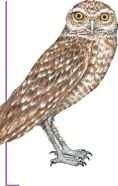
Burrowing owl
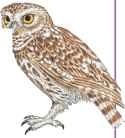
Little owl
| STAT Weight |
TATISTICS 5-5.5 oz. |
| Height | 7-9.5” |
| Wingspan | 20-24” |
| Sexual [ Maturity | 1 year |
| Breeding I Season | Late March -August |
| Number of Eggs | 6-11, but usually 7-9 |
| Incubation [ Period | 27-30 days |
| Fledging 1 Period | 40-45 days |
| Breeding ( Interval | 1 year |
| Typical Diet Lifespan |
Large insects and small vertebrates Up to 10 years |
RELATED SPECIES
• There are four subspecies of the burrowing owl: Athene cunicularia floridana, A.c. troglodytes, A.c. rostrata and A.c. hypugaea, which has the widest range.The family Strigidae has 138 species in 24 genera. In 1983 the genus Speotyto merged with the genus Athene. Other similar species of the genus Athene are forest-dwelling owls in India and southeast Asia.
